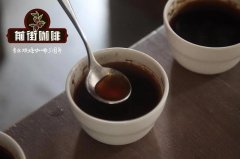Should coffee be steamed under Philharmonic pressure? what is the difference in flavor and taste between positive pressure and reverse pressure?

Professional coffee knowledge exchange more coffee bean information please follow the coffee workshop (Wechat official account cafe_style)
Philharmonic pressure is a very playable coffee utensil, because Philharmonic pressure can not only positive pressure, but also reverse pressure, and the installation of a tool can also make espresso, isn't it very powerful? So you may ask, is there any difference in the taste of coffee made by Philharmonic pressure positive pressure and reverse pressure? Does it need to be steamed to make coffee under Philharmonic pressure? Follow me to understand!
First of all, let's do an experiment with Colombian beans.
[Colombian caucus]
Producing area: Cauca Province
Altitude: 1758 m-2100 m
Variety: Kaddura
Treatment: washing treatment
[positive pressure]
Put the body of the Philharmonic pressure on top of the sharing pot, pour in the coffee powder and a certain proportion of hot water, steam and stir, then insert the piston cylinder and press down.
When using this method, there will be a phenomenon of "running water" when cooking, that is, the water will flow away while injecting water. The editor feels like a flat-bottomed filter cup, except that the filter cup is high and narrow, and the flow rate is slow when there is no pressure.
Flavor: aromas of spice and pine, with sour notes of lemon and grape on the palate, nutty, chocolate and cedar flavors in the middle, with creamy and sweet sugar in the finish.
[reverse pressure]
Put the Philharmonic pressure kettle body and pressure bar together, put it upside down, pour in the coffee powder and a certain proportion of hot water, steam and stir, then cover the filter cover and press the Philharmonic on the sharing pot.
Using reverse pressure to extract coffee is more likely to be extracted by soaking.
Flavor: it smells of spice and pine, with aromas of herbs and chocolate in the mouth, as well as soft grape acidity, obvious cedar wood in the middle, obvious caramel sweetness and high alcohol thickness.
In the positive pressure extraction, similar to the hand flushing, the coffee liquid will flow away a part, the extraction rate is relatively low and the concentration will be relatively low, so the flavor level will be relatively rich when drinking.
When using reverse pressure extraction, the coffee powder is soaked in hot water, and the overall extraction is relatively complete and uniform, so the extraction rate will be higher and the concentration will be higher, so when drinking it, the taste is more balanced and the sweetness is more obvious.
This is the end of the introduction of Philharmonic pressure to make coffee. Do you understand? Philharmonic pressure is also suitable for making coffee, because fresh beans will exhaust when they encounter water, which helps coffee release its aroma and flavor, and then extract it. You won't worry about the lack of extraction leading to the weak flavor of the coffee!
END
Important Notice :
前街咖啡 FrontStreet Coffee has moved to new addredd:
FrontStreet Coffee Address: 315,Donghua East Road,GuangZhou
Tel:020 38364473
- Prev

Classification and taste characteristics of coffee and which kind of coffee is more bitter?
Professional coffee knowledge exchange more coffee bean information Please pay attention to coffee workshop (Wechat official account cafe_style) Coffee has become an indispensable drink for more and more people, but many people are still dazzled when ordering. In fact, the correct way to open it is to choose according to your usual taste. Just watch the following carefully and you don't have to worry about it.
- Next

Hand filter cup choose which material is good to use | teach you how to use kono filter cup
Professional coffee knowledge exchange more coffee bean information Please pay attention to the coffee workshop (Wechat official account cafe_style) there are not many tools used for hand-brewing coffee, filter cups, hand pots, sharing pots, filter paper, electronic scales, thermometers and so on are indispensable, each of which may affect the flavor of coffee, if you do not make a good cup of coffee because of a certain link, making the customer's
Related
- Beginners will see the "Coffee pull flower" guide!
- What is the difference between ice blog purified milk and ordinary milk coffee?
- Why is the Philippines the largest producer of crops in Liberia?
- For coffee extraction, should the fine powder be retained?
- How does extracted espresso fill pressed powder? How much strength does it take to press the powder?
- How to make jasmine cold extract coffee? Is the jasmine + latte good?
- Will this little toy really make the coffee taste better? How does Lily Drip affect coffee extraction?
- Will the action of slapping the filter cup also affect coffee extraction?
- What's the difference between powder-to-water ratio and powder-to-liquid ratio?
- What is the Ethiopian local species? What does it have to do with Heirloom native species?

